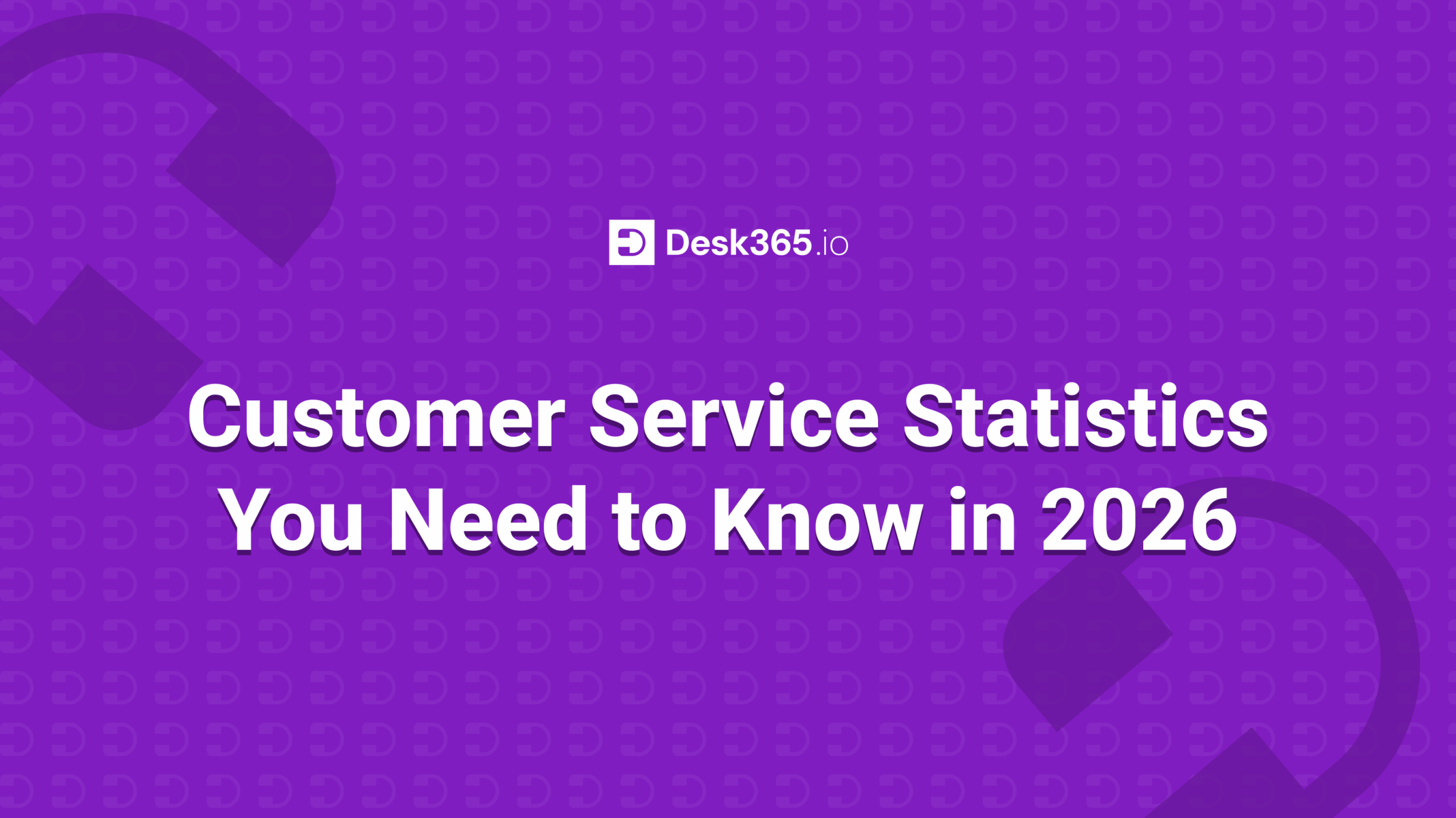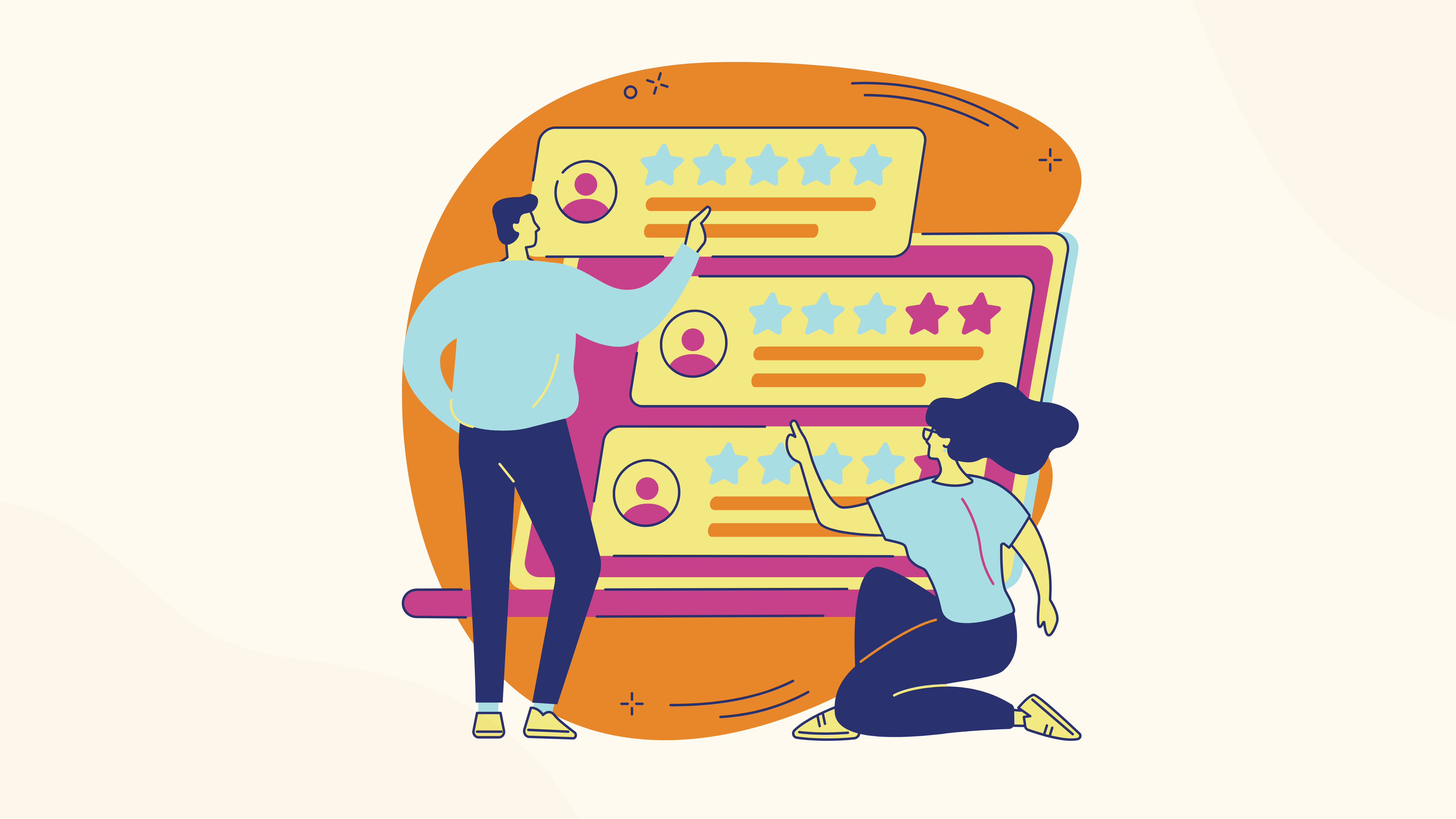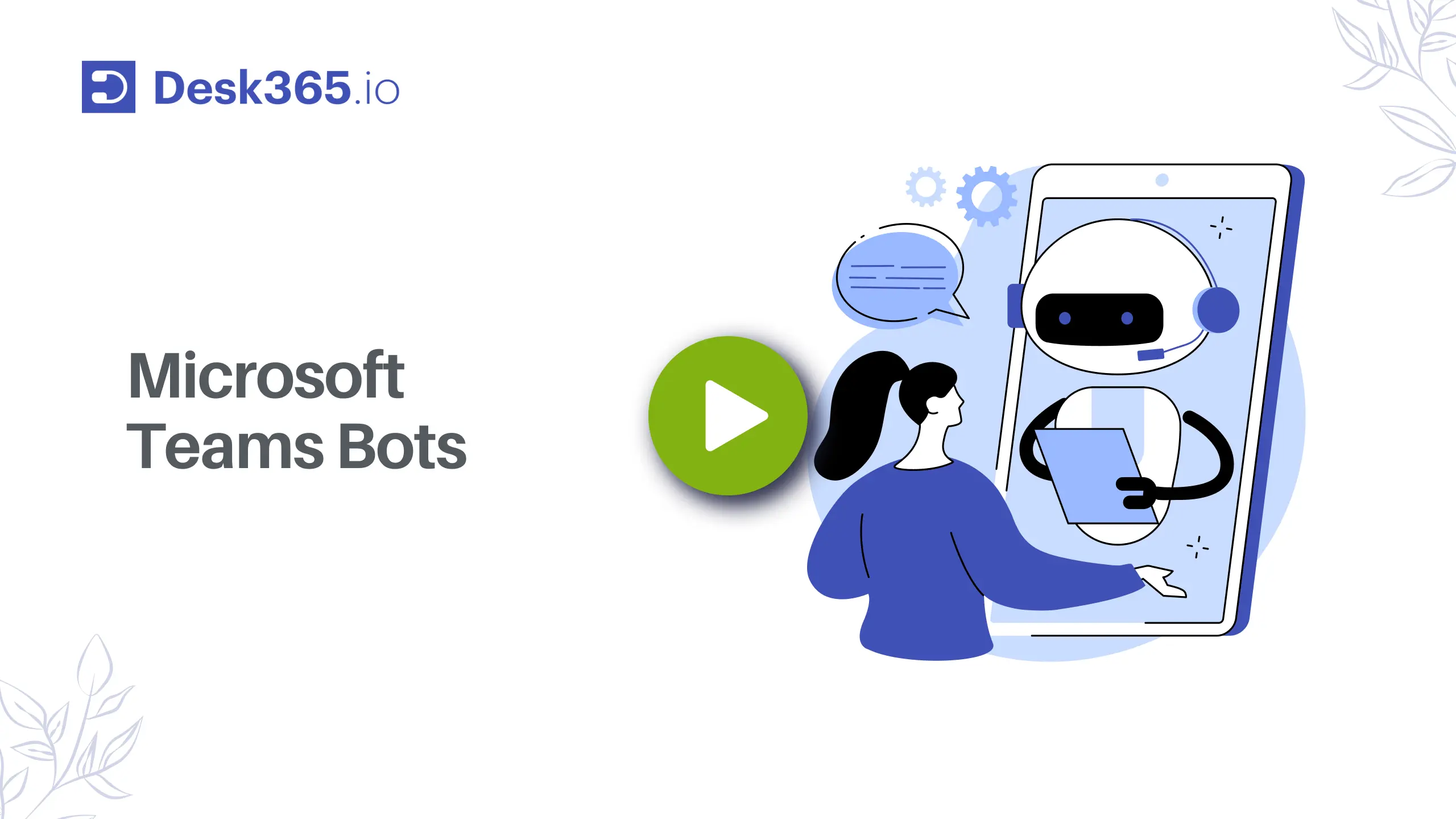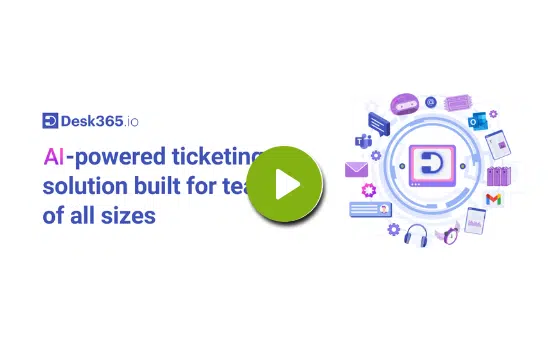In 2025, customer service is more important than ever. With many options available, people expect fast, personalized, and efficient help when needed. How a business handles customer service can make or break its reputation. This is where customer service statistics come in—they help companies see what’s working and what’s not.
By looking at the customer service statistics, businesses can spot trends, improve response times, and ensure they meet customer expectations. Tracking these numbers helps set clear goals and shows where changes are needed, making customer service a key part of long-term success.
Customer service statistics about customer satisfaction
Every business aims to deliver exceptional customer service, and it’s not just about the feel-good factor. Outstanding service is a powerful differentiator that can set your business apart, as reflected in these customer service statistics.
When done right, customer service can have as much influence as a strong sales funnel or an effective marketing strategy. Excellent support doesn’t just elevate the customer experience—it can also improve the efficiency of other teams across your organization.
When customers feel supported and valued, they are more inclined to make repeat purchases. Their positive experiences often turn into word-of-mouth recommendations, which are among the most valuable and impactful marketing tools available.
Still skeptical? Here are some key statistics that underscore how essential excellent customer service is for driving business success:
- Consumers give companies only 2.2 chances on average before switching. (Zendesk)
- Customers are willing to pay a 16% premium for great experiences. (SuperOffice)
- 5% of a company’s business comes from existing customers. (Small Business Trends)
- 93% of customers are more likely to make repeat purchases with companies that offer excellent customer service. (HubSpot)
- 52% of consumers say they have made an additional purchase after excellent service. (Dimensional Research)
- Customers who have a positive experience are 5x more likely to repurchase and 4x more likely to refer. (Temkin Group)
- 93% of customers are more likely to make repeat purchases with companies that offer excellent customer service. (HubSpot)
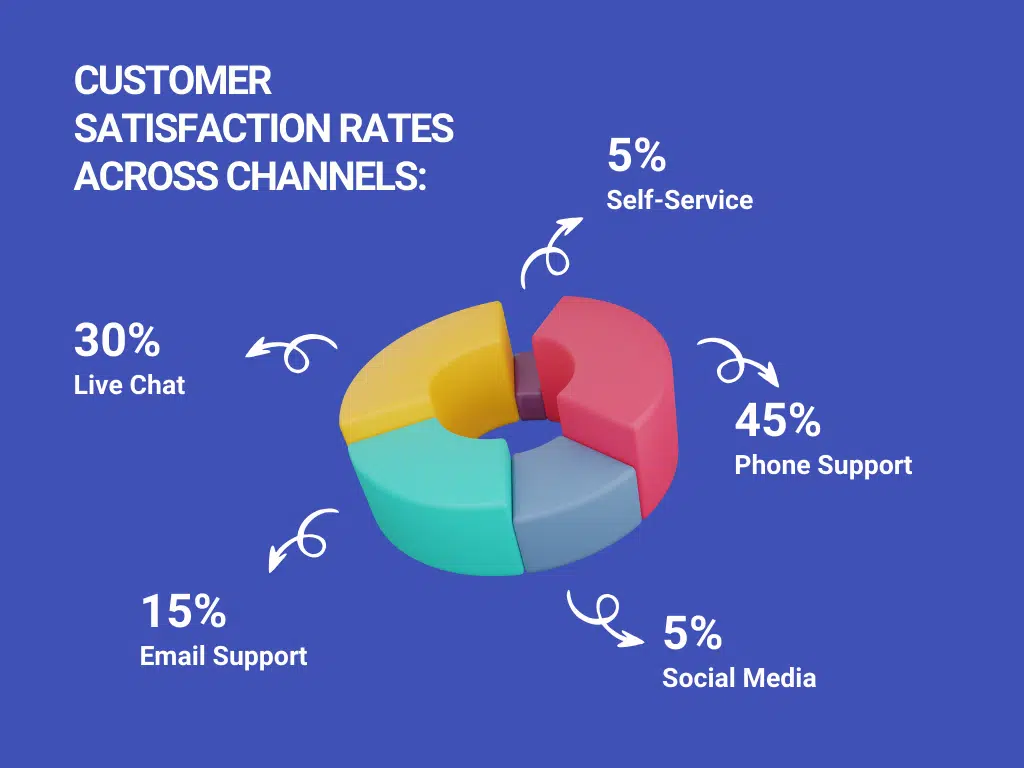
- Acquiring a new customer can cost 5 times more than retaining an existing one. (Forbes)
- 80% of a company’s future profits will come from just 20% of its existing customers. (Gartner)
- Increasing customer retention by just 5% can increase profits by 25% to 95%. (Bain & Company)
- 73% of consumers say friendly customer service is what makes them loyal to a brand. (HubSpot)
- 77% of consumers have stayed loyal to specific brands for over 10 years. (InMoment)
- 74% of loyal customers will recommend a company to friends and family.
- 89% of customers are more likely to make another purchase after a positive service experience. (Salesforce)
- 33% of consumers will switch brands after a single bad experience. (PwC)
As these numbers show, delivering great customer service can make a significant difference, no matter what your industry. It helps drive revenue, foster customer loyalty, and strengthen your business overall.
Metrics such as Customer Satisfaction Score (CSAT) and Net Promoter Score (NPS) provide valuable insights that help your service team improve and expand their influence. These insights also offer a roadmap for other customer-facing teams to identify areas for growth, ensuring your business consistently delivers value at every touchpoint. Who wouldn’t want to give their team that advantage?
Why losing customer trust could cost you big time?
Losing customer trust is one of the biggest challenges any business can face, and its impact can be devastating.
As Warren Buffett famously said, “It takes 20 years to build a reputation and five minutes to ruin it. If you think about that, you’ll do things differently.” Trust, once broken, can be nearly impossible to regain, and the fallout can extend far beyond a single lost customer.
When customers feel let down or misled by a brand, they are not just likely to stop buying—they can become vocal detractors, sharing their negative experiences online and within their social circles. This can tarnish a brand’s reputation faster than ever before, especially in the age of social media, where a single bad review can reach thousands.
Here are some key statistics that highlight the significant impact of bad customer experiences on businesses:
- 59% of customers will abandon a brand after a single poor experience. (PwC)
- 86% of buyers are willing to pay more for a great customer experience, but 32% will leave a brand they love after just one bad experience. (PwC)
- 73% of customers say a good experience with one company raises their expectations for all others. (Salesforce)
- 58% of customers say they would never use a company again after a negative customer service experience. (PR Newswire)
- 13% of dissatisfied customers will tell 15 or more people about their bad experience. (American Express)
- It takes 12 positive experiences to make up for one unresolved negative experience. (Ruby Newell-Legner)
- Only 10% of customers say brands meet their expectations for a good experience. (Forrester)
70% of consumers say technology makes it easier than ever to switch brands. (Salesforce)
- 91% of customers who are unhappy with a brand will leave without complaining. (HubSpot)
- 70% of customers believe a company is more focused on their profits than on their needs after a bad experience. (Salesforce)
- 77% of consumers view brands more favorably if they proactively seek and apply customer feedback, yet many companies fail to do this. (Microsoft)
- 42% of customers have left a business because they were frustrated by rude or unhelpful staff. (Zendesk)
These customer service statistics illustrate how a negative customer experience can significantly impact a business’s reputation, customer retention, and overall success.
Customer service statistics about word-of-mouth marketing
"A satisfied customer is the best business strategy of all." – Michael LeBoeuf
Happy customers are more than just repeat buyers—they are your brand’s biggest advocates. When a business delivers excellent customer service, it doesn’t just resolve issues; it creates experiences that people talk about. Word-of-mouth marketing thrives on such positive experiences, and in the digital age, one great interaction can ripple out to a vast audience through reviews, social media, and personal recommendations.
In contrast, poor customer service can have the opposite effect. A single negative experience can be shared widely, potentially reaching hundreds or even thousands of potential customers. This makes the role of customer service crucial in building a positive brand image and fostering organic growth through loyal advocates.
Let’s dive into the statistics that demonstrate the power of customer service in driving word-of-mouth marketing:
- 92% of consumers trust recommendations from friends and family over any other type of advertising. (Nielsen)
- 81% of consumers say that a positive customer service experience increases the likelihood that they will make another purchase. (Salesforce Research)
- 74% of consumers say that word-of-mouth is a key influencer in their purchasing decisions. (Ogilvy)
- 88% of consumers have been influenced by an online customer service review when making a purchasing decision. (Zendesk)
- 67% of consumers are likely to recommend a company that provides exceptional service. (HubSpot)
- 77% of customers are likely to share their positive experiences on social media. (American Express)
- 94% of consumers who give a business a “very good” rating is more likely to recommend it. (Qualtrics)
- 50% of customers say that after a positive experience with a company, they are more likely to post a review or recommend the brand. (Salesforce)
- 68% of customers leave a review after a positive experience, and 29% do so after a negative experience. (BrightLocal)
- Companies that excel in customer experience grow 4-8% above their market average. (Bain & Company)
- 70% of consumers are more likely to recommend a company that responds quickly to their inquiries. (Twitter)
These customer service statistics underscore the vital role that customer service plays in word-of-mouth marketing. Positive experiences turn customers into advocates who spread the word, while negative experiences can have far-reaching consequences for a brand’s reputation and success.
Customer expectations: What do they really want?
"People do not care how much you know until they know how much you care." – Theodore Roosevelt
Modern customers expect more than just good products—they want fast, personalized service that meets their needs wherever they are. With the rise of digital communication channels, customers expect to get their questions answered and problems solved quickly, and they value companies that provide a seamless, consistent experience across multiple platforms. Meeting these high expectations is no longer optional; it’s a necessity for retaining customers and staying competitive in the market.
Customers are increasingly willing to switch brands if their expectations aren’t met. On the other hand, when brands provide a high level of personalization and efficient service, customers are more likely to become loyal advocates. Let’s look at the statistics that highlight these shifting customer expectations:
- 73% of consumers say customer experience is a key factor in their purchasing decisions, even more so than price and product quality. (PwC)
- 90% of customers expect a consistent experience across all channels, including online, mobile, and in-person interactions. (SDL)
- 70% of customers believe that companies should collaborate on their behalf to provide seamless service. (Salesforce)
- 60% of millennials surveyed expect a consistent experience from brands whether online, in store or via phone. (SDL)
- 64% of consumers expect companies to respond to their inquiries in real-time. (Salesforce)
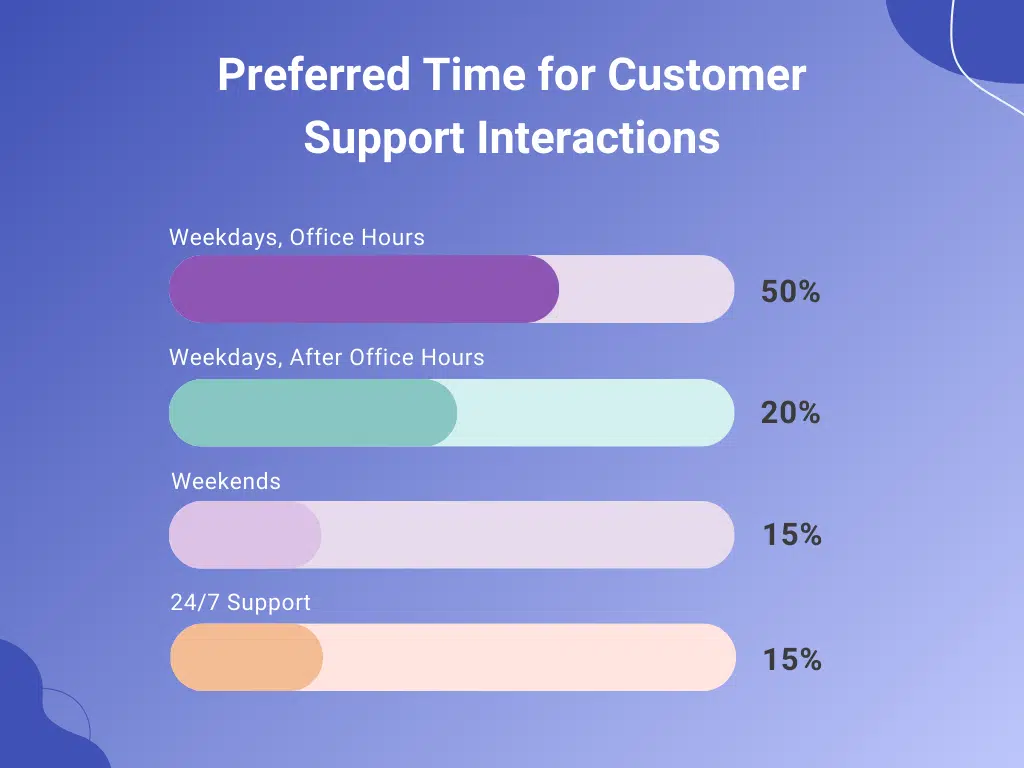
- 75% of customers are more likely to purchase from a company that knows their name and purchase history and recommends products based on that information. (Accenture)
- 79% of customers expect to interact with customer service representatives through social media channels. (Statista)
- 60% of consumers say that quick resolution times are critical to their experience with a company. (Forrester)
- 66% of consumers expect brands to understand their unique needs and expectations. (Salesforce)
- 57% of customers will abandon a brand if they find a better experience elsewhere. (Salesforce)
- 89% of consumers want to connect with brands through different channels and expect a seamless transition between them. (Khoros)
- 67% of customers prefer self-service options over speaking to a company representative. (Zendesk)
- 58% of consumers feel that companies don’t have a good understanding of their needs. (Salesforce)
- 54% of millennials are willing to spend more on a company that offers a high level of customer service. (Microsoft)
- 74% of customers say they’re likelier to stick with a brand that understands them and delivers relevant communication. (Business2Community)
- 88% of consumers say that the ability to communicate with a business via multiple channels is critical. (Twilio)
These customer service statistics demonstrate that customers expect speed, personalization, and omnichannel support from the brands they interact with. Meeting these expectations is essential for building loyalty and fostering positive relationships with customers, ultimately driving long-term business success.
Customer service statistics about customer service metrics
"What gets measured gets managed." – Peter Drucker
In customer service, tracking the right metrics is essential for understanding customer satisfaction and driving improvements. Metrics like Customer Satisfaction Score (CSAT), Net Promoter Score (NPS), and First Response Time (FRT) offer valuable insights into how well a company is meeting customer expectations. By monitoring these key indicators, businesses can identify areas for improvement, enhance the customer experience, and ultimately boost retention and loyalty.
Let’s dive into the statistics that highlight the importance of these customer service metrics:
- 45% of customers are willing to switch brands if a company fails to measure their satisfaction effectively. (Forrester)
- Businesses that track CSAT scores see a 33% higher retention rate. (HubSpot)
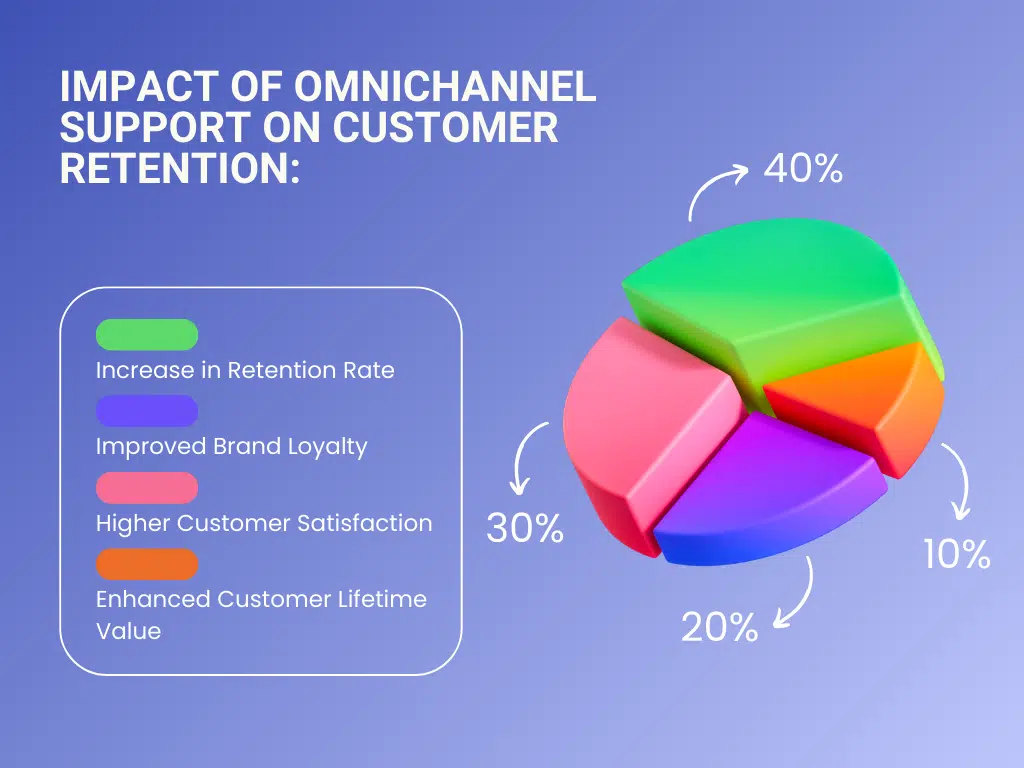
- 60% of companies that actively measure NPS report faster growth than their competitors. (Bain & Company)
- 88% of high-performing companies use CSAT as a primary measure of customer satisfaction. (Zendesk)
- 72% of customers expect a response within 30 minutes of reaching out, making FRT a critical factor for customer satisfaction. (SuperOffice)
- 50% of companies that track NPS have been able to increase customer referrals by 10% or more. (Satmetrix)
- 68% of customers who receive a response within one hour are more likely to become repeat customers. (Harvard Business Review)
- A 10% increase in NPS can lead to a 6-7% increase in revenue. (Medallia)
These customer service statistics demonstrate how tracking metrics like CSAT, NPS, and First Response Time can help businesses enhance their customer service strategies. By focusing on these critical metrics, companies can better understand their customers’ needs, improve satisfaction, and drive long-term success.
Customer service statistics about personalization
"People don’t care how much you know until they know how much you care." – Theodore Roosevelt
Customers crave a personal touch that makes them feel valued and understood. Personalization in customer service means going beyond generic responses and tailoring interactions based on each customer’s history, preferences, and needs. This approach not only makes customers feel more appreciated but also significantly improves their overall experience with a brand.
When companies take the time to understand and anticipate customer needs, they create deeper connections that can lead to increased loyalty and satisfaction. Personalized service can turn routine transactions into meaningful interactions, making customers feel like they are more than just a number. As a result, businesses that embrace personalization often see a boost in customer retention, positive reviews, and revenue growth.
Here are some statistics that show the impact of personalized customer service:
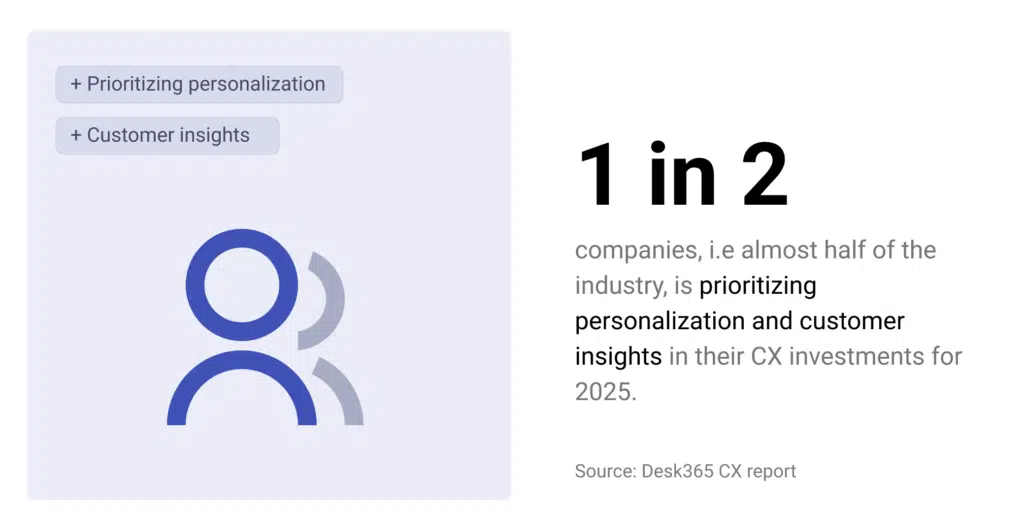
- 1 in 2 companies, i.e, almost half of the industry, is prioritizing personalization and customer insights in their CX investments for 2025. (Desk365 CX report)
- 80% of consumers are more likely to purchase from a brand that offers personalized experiences. (Epsilon)
- 76% of customers become frustrated when companies fail to offer personalized interactions. (McKinsey)
- Companies that excel at personalization can see a revenue increase of 10-15%. (McKinsey)
- 63% of consumers expect personalization as a standard service. (Salesforce)
- 77% of customers have chosen, recommended, or paid more for a brand that provides a personalized service experience. (Forrester)
- 48% of customers spend more when their experience is tailored to their needs. (Segment)
Examples of companies excelling in personalization
1. Amazon
Amazon has set a high bar for personalized customer service. By leveraging purchase history, browsing behavior, and customer data, Amazon tailors product recommendations, emails, and even the user’s home page layout. This approach has helped Amazon achieve higher sales conversion rates and customer loyalty.
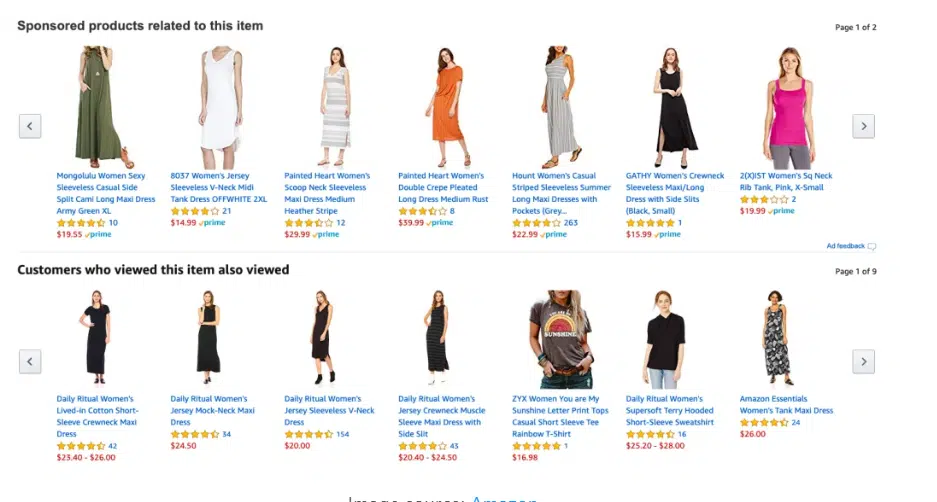
2. Netflix
Netflix’s recommendation algorithm is one of the best examples of personalization. By analyzing user viewing history, ratings, and preferences, Netflix curates content suggestions that keep users engaged and returning for more. This focus on personalized recommendations has been a key factor in Netflix’s high retention rates.
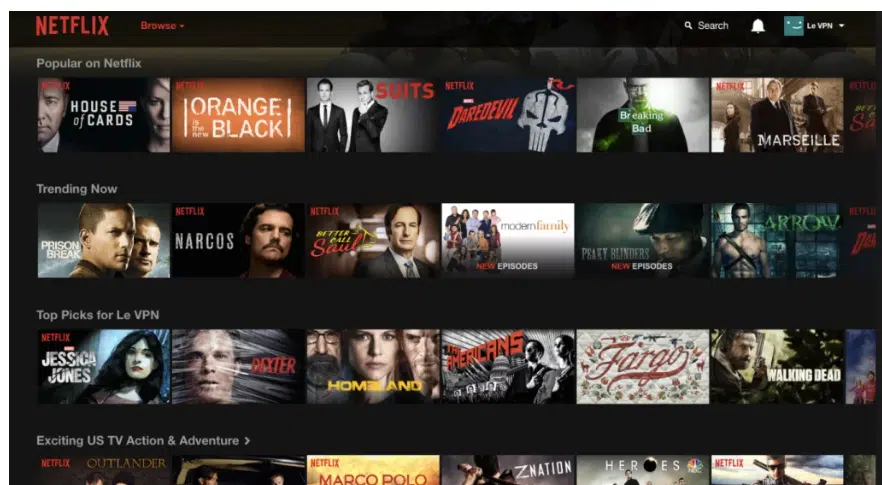
3. Spotify
Spotify’s use of personalized playlists like “Discover Weekly” is a powerful example of how tailoring experiences can increase user satisfaction. By analyzing listening habits, Spotify creates playlists and recommendations that are unique to each user, keeping them engaged and invested in the platform.
These companies have mastered the art of personalization, making their customers feel valued and understood. As the statistics show, providing a personalized customer experience is not just a nice-to-have—it’s a powerful strategy for building stronger relationships and driving business growth.

The role of customer feedback: Turning data into actionable insights
"Your most unhappy customers are your greatest source of learning." – Bill Gates
Customer feedback is the lifeblood of any business looking to improve and adapt to the needs of its audience. Gathering feedback allows companies to identify what they are doing well and, more importantly, where they need to improve. By turning this feedback into actionable insights, businesses can make informed decisions that enhance their service, boost customer loyalty, and ultimately drive growth.
Let’s explore some statistics that underscore the importance of customer feedback in shaping successful business strategies:
- 77% of customers view brands more favorably if they proactively seek and apply their feedback. (Microsoft)
- 52% of customers believe companies need to take action on feedback provided by them. (Salesforce)
- 70% of customers who have a positive experience with a business after providing feedback are more likely to become loyal advocates. (HubSpot)
- Companies that actively use customer feedback for product improvements and service enhancement see a 10% increase in customer retention rates. (Qualtrics)
-
7% of consumers report responding to every survey they receive, while 22% respond to most, and 34% respond to some. (Khoros)
- 66% of consumers say they feel more valued when their feedback is acknowledged. (Zendesk)
- Businesses that close the loop on customer feedback are 2.5 times more likely to retain their customers. (Gartner)
- 89% of customers are willing to share a positive review after a company takes action based on their feedback. (Trustpilot)
- 85% of companies that prioritize customer feedback see an increase in revenue, showing the direct financial impact of listening to customers. (Harvard Business Review)
- 72% of consumers believe that companies that ask for feedback care more about providing good service. (Forrester)
Customer service statistics about AI and machine learning
"Artificial Intelligence is the new electricity." – Andrew Ng
AI and machine learning are transforming customer service by automating routine tasks, delivering faster responses, and offering more personalized support experiences. From chatbots that can handle basic inquiries to predictive analytics that anticipate customer needs, AI is revolutionizing the way companies interact with their customers. As AI continues to evolve, its role in customer service is only expected to grow, making it a critical component for businesses looking to stay competitive.
Let’s look at some key statistics that illustrate the current adoption of AI in customer support and predictions for its future impact:
- 85% of customer interactions are expected to be handled without a human agent by 2025, thanks to AI advancements. (Gartner)
47% faster response times — that’s how much AI has improved customer service at iMoving, by integrating an AI-powered chat and quote system (Desk365.io)
- 56% of companies are already using AI-powered chatbots to streamline customer service operations. (Salesforce)
- 64% of consumers say they prefer AI-driven instant messaging to phone support for simple questions. (Forrester)
- Businesses that implement AI to enhance customer service report a 30% increase in efficiency. (McKinsey)
- 75% of customers expect AI-powered tools to improve their experience by providing faster responses. (HubSpot)
- 40% of businesses are planning to expand their use of AI in customer service over the next year. (Deloitte)
- 61% of companies believe that AI in customer service will enable them to identify valuable insights from customer interactions. (IDC)
- AI tools that analyze customer sentiment can increase first-call resolution rates by 20%. (SuperOffice)
Customer service statistics about social media
"Your brand is what people say about you when you’re not in the room." – Jeff Bezos
Social media has become much more than a platform for sharing photos and updates—it’s now a critical channel for customer support. As consumers spend more time on platforms like Twitter, Facebook, and Instagram, they increasingly expect brands to be present and responsive there too. Social media’s speed and public nature make it an ideal space for customers to ask questions, voice concerns, and receive quick support. For businesses, this shift represents an opportunity to engage with customers directly, resolve issues in real-time, and manage their reputation more transparently.
Let’s explore some statistics that highlight the growing use of social media for customer support:
- 67% of consumers have used social media platforms like Twitter, Facebook, or Instagram for customer service needs. (JD Power)
- 88% of customers say they are less likely to buy from a brand that leaves complaints on social media unanswered. (Conversocial)
- 70% of customers expect to receive a response on social media within 24 hours, while 42% expect a response within just 60 minutes. (Sprout Social)
- 80% of consumers use social media to engage with brands and seek support. (Hootsuite)
- Social media response times can impact customer satisfaction, with 65% of consumers reporting that fast response times on social media improve their opinion of a brand. (Khoros)
Examples of how brands manage social media interactions
Delta Airlines
Delta is known for its quick responses on Twitter. By using a dedicated support account, @DeltaAssist, they are able to address customer queries and complaints almost instantly, making travelers feel heard even during delays or travel disruptions. This swift action has helped Delta maintain a strong reputation in the competitive airline industry.
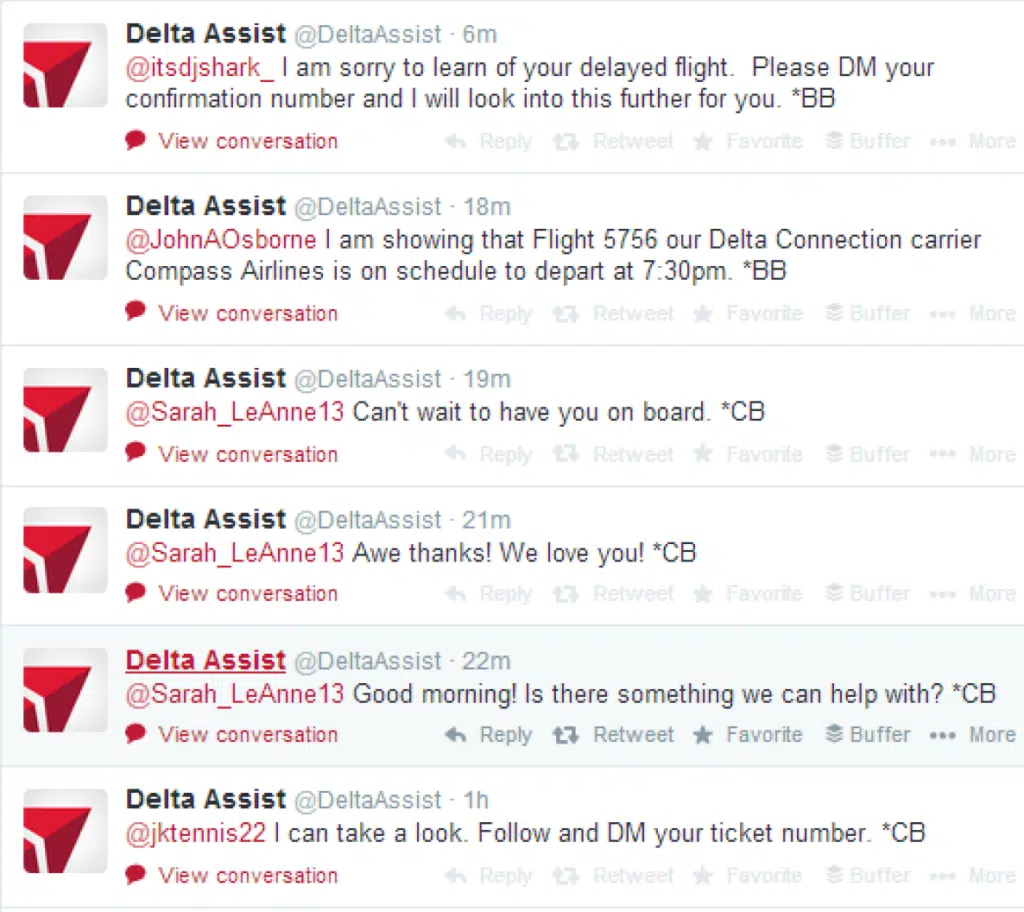
Zappos
Zappos is known for its exceptional customer service, and its approach extends to social media. They respond to customer queries with a friendly, personable style and often go the extra mile by sending surprise gifts or thank-you notes. This proactive approach has helped solidify Zappos’ reputation as a customer-centric brand.
These examples show that brands that use social media effectively for customer support can enhance their reputation and build deeper connections with their audience. As these statistics demonstrate, social media is no longer an option.
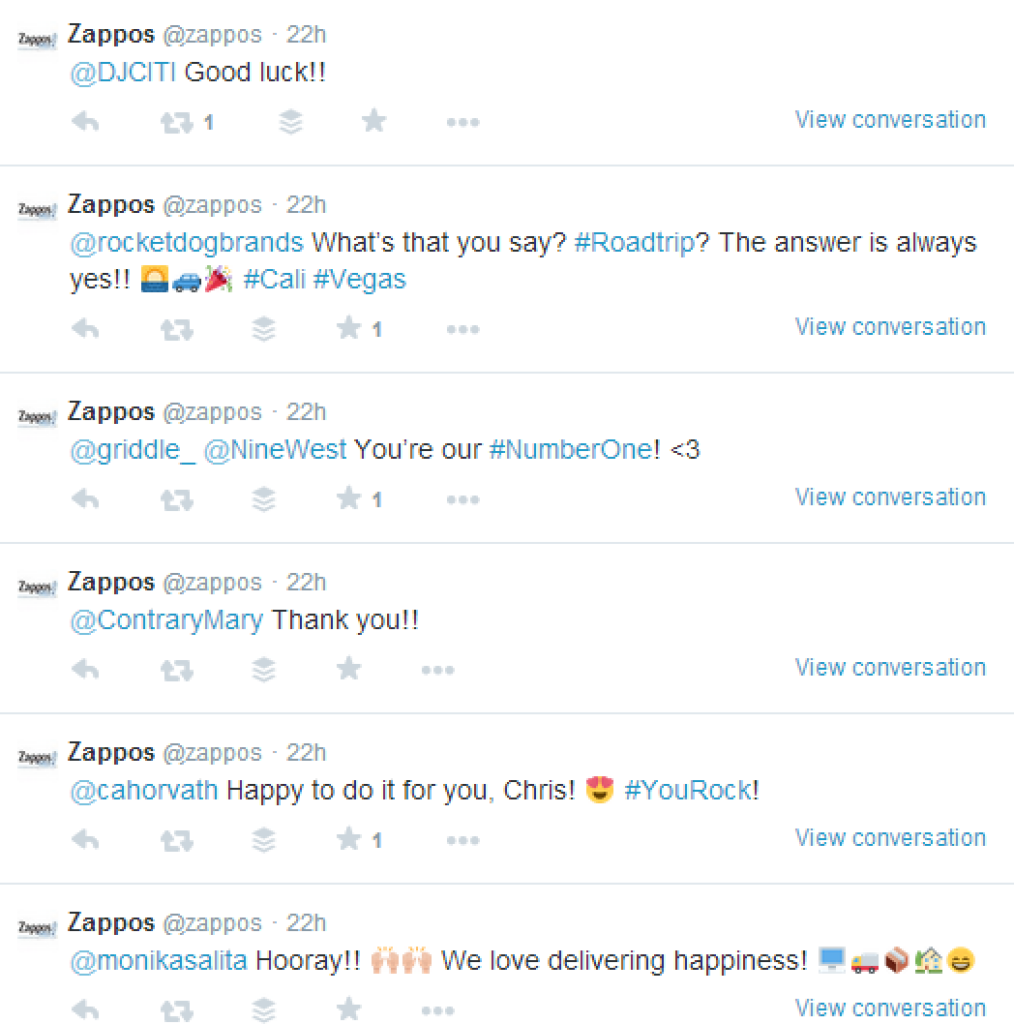
Self-service and automation: The new norm in customer support
"Automation applied to an inefficient operation will magnify the inefficiency." – Bill Gates
In recent years, self-service and automation have become essential components of modern customer support. With the rise of self-service portals, chatbots, and AI-powered tools, customers now have the ability to find answers and resolve issues on their own, without waiting for a human representative. This shift has transformed the customer experience, providing greater convenience while enabling businesses to manage support requests more efficiently.
Self-service options like knowledge bases, AI chatbots, and automated workflows allow customers to quickly access information, troubleshoot problems, and complete routine tasks without needing to reach out to support teams.
Let’s explore some statistics that highlight the growing trend of self-service and automation in customer support:
- 81% of customers attempt to resolve issues themselves before reaching out to a live representative. (Harvard Business Review)
- 69% of customers prefer to use self-service options like a knowledge base or chatbot over contacting support. (Zendesk)
- 85% of customer interactions are expected to be handled without human involvement by 2025, thanks to AI and automation. (Gartner)
- Companies that use AI chatbots for customer service see a 30% reduction in support costs. (Accenture)
- 67% of consumers say they prefer self-service over speaking to a customer representative for simple inquiries. (Forrester)
- 70% of customers expect a company’s website to include a self-service application. (Forrester)
- Self-service portals can reduce support call volumes by 25-30%, allowing agents to focus on more complex queries. (McKinsey)
- 91% of customers would use an online knowledge base if it were tailored to their needs. (Zendesk)
- 56% of companies that implement AI and chatbots report improved agent productivity and better customer satisfaction. (IBM)
Customer service statistics about the role of speed in customer service satisfaction
In the age of instant communication, speed has become a critical factor in customer service satisfaction. Today’s customers expect quick responses and timely solutions, and any delay can significantly impact their perception of a brand. Speed in customer service doesn’t just mean responding quickly to initial inquiries—it also means resolving issues swiftly to ensure customers feel valued and heard.
When businesses prioritize speed, they create a positive experience that can lead to higher levels of customer satisfaction and loyalty. On the other hand, slow response times can frustrate customers, leading them to seek alternatives and even share negative experiences with others. For companies, balancing speed with quality is key to providing effective support that keeps customers coming back.
Here are some key statistics that highlight the impact of response time on customer satisfaction:
- 60% of customers define their customer service experience as satisfactory when they receive a quick resolution. (Forrester)
- 90% of consumers rate an “immediate” response as important when they have a customer service question, with 60% defining “immediate” as 10 minutes or less. (HubSpot)
- 70% of customers expect a response from brands on social media within 24 hours, but 42% expect a reply within 60 minutes. (Sprout Social)
- Businesses that respond to customer service emails within one hour are 7 times more likely to convert a lead into a customer. (Harvard Business Review)

- 78% of customers say that getting their issue resolved quickly is the most important factor in a positive customer experience. (Salesforce)
- 53% of customers will leave a brand they love after just one poor customer service experience, especially if it involves long response times. (PwC)
- The average response time for customer service chat is 2 minutes, but customers expect replies within 45 seconds to feel satisfied. (SuperOffice)
- 82% of consumers expect an immediate response when contacting brands through live chat. (Salesforce)
- 67% of customers say that faster response times significantly improve their satisfaction with a company. (Zendesk)
How to use customer service statistics to improve your strategy?
Understanding and leveraging customer service statistics can be a game-changer for businesses looking to enhance their customer support strategies.
The data shows that customers today prioritize speed, personalization, and consistency across various communication channels. With 90% of consumers expecting immediate responses, and 76% feeling frustrated when interactions aren’t personalized, it’s clear that businesses need to adapt to meet these rising expectations.
Additionally, statistics reveal that customers value proactive communication and seamless experiences, with 73% using multiple channels during their journey and expecting a unified experience.
Frequently asked questions
93% of customers are likely to make repeat purchases with companies that offer excellent customer service customers are five times more likely to purchase again and four times more likely to refer the brand to others .
Poor customer service costs a billion with customers frequently switching to competitors (73%) or changing their purchase decisions (78%) after a single bad experience. Brands can lose customers due to factors like unresolved issues, transfers between departments (68%), or unhelpful staff (42%). Additionally, negative customer experiences can significantly damage brand perception and are often shared on social media, highlighting the need for businesses to improve customer support.
Customer satisfaction statistics show that the average Customer Satisfaction Score (CSAT) across industries is around 78%, with most companies aiming for a healthy range between 70% and 90%. In the U.S., the American Customer Satisfaction Index (ACSI) reported an overall score of 76.9 out of 100 in 2025, showing relatively stable performance across sectors. Studies also highlight that 76% of recent customer interactions are rated positively (4 or 5 stars), while industry-specific benchmarks, such as 75–85% CSAT in e-commerce, show how performance can vary by sector.

